

E textiles, Soft circuits, Wearable electronics. MaKey MaKey Scratch Interactive 'Zines. The beauty of the Interactive Storybook and the praise I received for the project prompted me to continue exploring the idea and form.I took my own advice and remixed Praxis' Interactive 'Zine design.
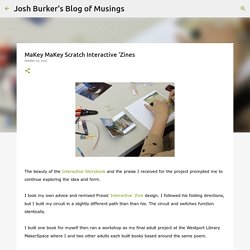
I followed his folding directions, but I built my circuit in a slightly different path than than his. The circuit and switches function identically.I built one book for myself then ran a workshop as my final adult project at the Westport Library MakerSpace where I and two other adults each built books based around the same poem.Like the Storybook, I collaged my example book. The workshop participants also collaged their pages.I used a short Richard Brautigan poem, "Widow's Lament" as the text in my 'zine.After folding and cutting the paper I collaged the story. I chose black and white or grayscale images in keeping with the mood and setting of the story. The Scratch project enhances the story as the reader interacts with the 'zine by starting sound effects, different ones for each page. Sketchbook Sample: Circuits + origami. Aula STEAM : E-textiles para integrar el Arte en el modelo educativo STEM. Additional E-textiles Modules – Exploring Computer Science. Circuitos textiles.
Intro to Sewing Circuits for Schools: 3 Steps. AdWords.

DIY Paper Circuit Card: 6 Steps. AdWords We use AdWords to deploy digital advertising on sites supported by AdWords.
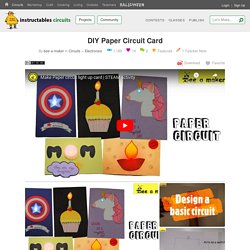
Tinkering Project: Sewn Circuits. ScratchPaper: 10 Steps. AdWords We use AdWords to deploy digital advertising on sites supported by AdWords.
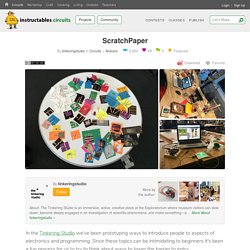
Ads are based on both AdWords data and behavioral data that we collect while you’re on our sites. Turn Signal Biking Jacket: 8 Steps. AdWords We use AdWords to deploy digital advertising on sites supported by AdWords.

Ads are based on both AdWords data and behavioral data that we collect while you’re on our sites. The data we collect may include pages you’ve visited, trials you’ve initiated, videos you’ve played, purchases you’ve made, and your IP address or device ID. How to Make a Sewable Rocket Key Ring Torch. Guía de iniciación CPE Tecnoteka. Libro Circuit Playground Express. Make It Log. The Past Before the advent of computers, all data was written in notebooks.
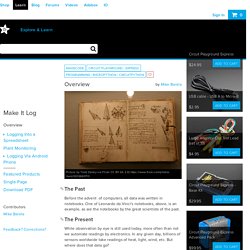
One of Leonardo da Vinci's notebooks, above, is an example, as are the notebooks by the great scientists of the past. The Present. Distance Measurement with Ultrasound. The common HC-SR04 boards are designed for 5V TTL voltage levels.
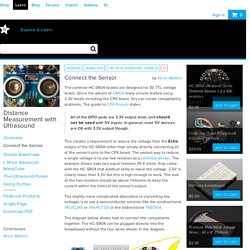
Since the advent of CMOS many circuits started using 3.3V levels including the CPX board, this can create compatibility problems. The guide to CPX Pinouts states: All of the GPIO pads are 3.3V output level, and should not be used with 5V inputs. In general, most 5V devices are OK with 3.3V output though. This creates a requirement to reduce the voltage from the Echo output of the HC-SR04 rather than simply directly connecting all of the sensor's pins to the CPX board.
Code Your Micro. It's fairly easy to code reading a switch in most languages.
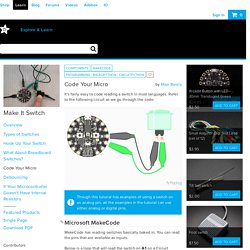
Refer to the following circuit as we go through the code: Though this tutorial has examples of using a switch on an analog pin, all the examples in the tutorial can use either analog or digital pins. MakeCode has reading switches basically baked in. You can read the pins that are available as inputs. Below is a loop that will read the switch on A1 on a Circuit Playground Express. Get MakeCode for Adafruit - Microsoft Store en-AU. Google Image Result for. DIY PROJECTS. To Sew Electric and the marvelous world of electronic textiles!
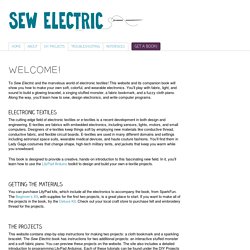
This website and its companion book will show you how to make your own soft, colorful, and wearable electronics. You’ll play with fabric, light, and sound to build a glowing bracelet, a singing stuffed monster, a fabric bookmark, and a fuzzy cloth piano. Along the way, you’ll learn how to sew, design electronics, and write computer programs. Etextiles box. E-Textiles and Wearables Tutorials & Resources. E-Textiles Curriculum & Projects – Exploring Computer Science. Stitching the Loop: Electronic Textiles in Exploring CS.
BodyVis Prototype 2.1 Demo. Pinterest. Pinterest. PrototipadoLAB : E-textiles, Wearables + Paper Circuits ___//.▲.\__ Empezando con LilyPad Arduino ~ Arduino.cl. Este es un tutorial rápido para empezar a coser un simple circuito y controlar LEDS, usando la placa Arduino LilyPad.
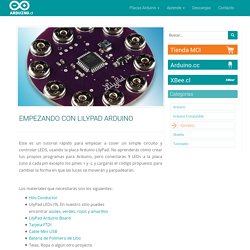
No aprenderás cómo crear tus propios programas para Arduino, pero conectarás 9 LEDs a la placa (uno a cada pin excepto los pines + y -), y cargarás el código propuesto para cambiar la forma en que las luces se moverán y parpadearán. Los materiales que necesitarás son los siguientes: Recomendado (pero no necesario): Bastidor En primer lugar, visita la página y descarga el software de Arduino si es que aún no lo tienes. Echa un vistazo a tu placa LilyPad – tiene 11 pads que pueden ser conectados a cualquier cantidad de dispositivos interesantes. Para comenzar, enhebra tu aguja con el hilo conductor, y cose tu placa sobre la tela que quieras, en el agujero titulado “5? Ahora hilvana un hilo desde este punto hacia donde quieras que esté tu primer LED, luego cóselo al pad positivo de tu LED. Enrolla y corta tu hilo. Ahora sólo faltan 2 pads. Ahora cargarás el programa. LilyTiny Plush Monster. Favorited Favorite 6 Introduction Craft a glowing-eyed stuffed monster while exploring the LilyTiny preprogrammed microcontroller.
This is a project based on the Tiny Monster Activity created at MIT’s High-Low Tech Lab by Emily Lovell, Jie Qi, and Natalie Freed. Tutorial Peanut. Soft Electronics Tutorials. Specialized Materials The tools and materials for creating soft circuits are pretty standard: you need your electronic components and their tools, and your soft materials and their tools. Anything that conducts electricity can be interesting here: snaps can be switches; hooks and eyes can too. There is only one special ingredient: conductive thread. This embroidery-floss-like material is the wire that makes soft circuits possible.
PROJECTS. An exploration into the possibilities for individual construction and customization of the most ubiquitous of electronic devices, the cellphone. … more Electronic Popables Electronic Popables is an interactive pop-up book that sparkles, sings, and moves. The book integrates traditional pop-up mechanisms with thin, flexible, paper-based electronics and the result is a book that … more Codeable Objects Codeable Objects is a library for Processing that enables novice coders, designers and artists to rapidly design, customize and construct an artifact using geometric computation and digital fabrication The programming … more. E-Textiles: an Introduction to Our Electro-Fashion Range. Amidst the hype surrounding wearable technology, we, too, have been deeply inspired by the craze.
As a result, we have designed our own range of E-Textiles parts in a bid to help lessen the gap between Electronics and textiles: Electro-Fashion. Discover just how easy it is to conduct your own E-Textiles project using our Electro-Fashion range and be a part of this global infatuation with fashionable electronics. An E-Textiles project by Laura Cooper, a Design and Technology Education undergraduate at Nottingham Trent University. Electro-Fashion Starter Pack, Standard Cell Holder, parts. E-Textiles & Visual Arts TechniquesE-Textiles & Visual Arts Techniques. Este tutorial de iniciación a los e-textiles lo he diseñado para el proyecto #Caseando invitada por Hirikilabs. Mas información aqui. TUTORIALES Y RECURSOS DIY – Blog.
En los últimos años, gracias al apoyo de una gran comunidad activa de investigadores, hobbistas, diseñadores, makers, ingenieros y sobre todo de personas interesadas en democratizar el uso de las tecnologías, se pueden encontrar en la red diferentes tutoriales , materiales y herramientas que nos ayudan a iniciarnos en los e-textiles. Para todos los que estéis interesados en conocer mas sobre este campo de investigación o realizar algún proyecto este campo os dejo una lista con recursos que iré actualizando cada poco tiempo.
Es.pinterest.